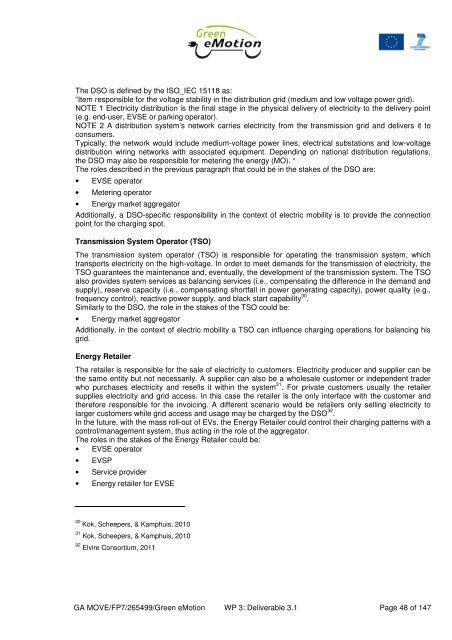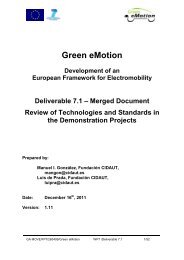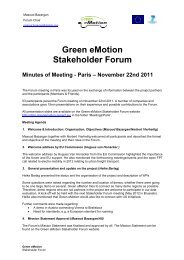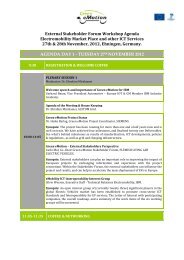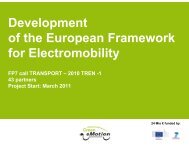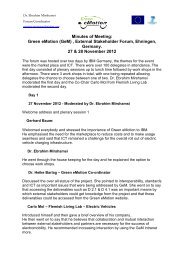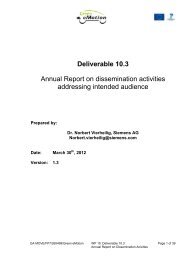Deliverable 3.1 Business Analysis - Green eMotion Project
Deliverable 3.1 Business Analysis - Green eMotion Project
Deliverable 3.1 Business Analysis - Green eMotion Project
You also want an ePaper? Increase the reach of your titles
YUMPU automatically turns print PDFs into web optimized ePapers that Google loves.
The DSO is defined by the ISO_IEC 15118 as:<br />
“Item responsible for the voltage stability in the distribution grid (medium and low voltage power grid).<br />
NOTE 1 Electricity distribution is the final stage in the physical delivery of electricity to the delivery point<br />
(e.g. end-user, EVSE or parking operator).<br />
NOTE 2 A distribution system’s network carries electricity from the transmission grid and delivers it to<br />
consumers.<br />
Typically, the network would include medium-voltage power lines, electrical substations and low-voltage<br />
distribution wiring networks with associated equipment. Depending on national distribution regulations,<br />
the DSO may also be responsible for metering the energy (MO). “<br />
The roles described in the previous paragraph that could be in the stakes of the DSO are:<br />
• EVSE operator<br />
• Metering operator<br />
• Energy market aggregator<br />
Additionally, a DSO-specific responsibility in the context of electric mobility is to provide the connection<br />
point for the charging spot.<br />
Transmission System Operator (TSO)<br />
The transmission system operator (TSO) is responsible for operating the transmission system, which<br />
transports electricity on the high-voltage. In order to meet demands for the transmission of electricity, the<br />
TSO guarantees the maintenance and, eventually, the development of the transmission system. The TSO<br />
also provides system services as balancing services (i.e., compensating the difference in the demand and<br />
supply), reserve capacity (i.e., compensating shortfall in power generating capacity), power quality (e.g.,<br />
frequency control), reactive power supply, and black start capability 30 .<br />
Similarly to the DSO, the role in the stakes of the TSO could be:<br />
• Energy market aggregator<br />
Additionally, in the context of electric mobility a TSO can influence charging operations for balancing his<br />
grid.<br />
Energy Retailer<br />
The retailer is responsible for the sale of electricity to customers. Electricity producer and supplier can be<br />
the same entity but not necessarily. A supplier can also be a wholesale customer or independent trader<br />
who purchases electricity and resells it within the system 31 . For private customers usually the retailer<br />
supplies electricity and grid access. In this case the retailer is the only interface with the customer and<br />
therefore responsible for the invoicing. A different scenario would be retailers only selling electricity to<br />
larger customers while grid access and usage may be charged by the DSO 32 .<br />
In the future, with the mass roll-out of EVs, the Energy Retailer could control their charging patterns with a<br />
control/management system, thus acting in the role of the aggregator.<br />
The roles in the stakes of the Energy Retailer could be:<br />
• EVSE operator<br />
• EVSP<br />
• Service provider<br />
• Energy retailer for EVSE<br />
30 Kok, Scheepers, & Kamphuis, 2010<br />
31 Kok, Scheepers, & Kamphuis, 2010<br />
32 Elvire Consortium, 2011<br />
GA MOVE/FP7/265499/<strong>Green</strong> <strong>eMotion</strong> WP 3: <strong>Deliverable</strong> <strong>3.1</strong> Page 48 of 147


